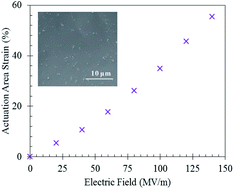An aluminum nanoparticle–acrylate copolymer nanocomposite as a dielectric elastomer with a high dielectric constant†
Abstract
Dielectric elastomers are useful for large-strain actuation, sensing and energy generation. The low dielectric constants of these elastomers require rather high driving voltages, which has limited their application potential. Various high dielectric constant filler materials have been investigated to increase the dielectric constants and improve the actuation strains, force outputs, and energy densities of the compliant polymer actuators and generators. We report the synthesis of a high dielectric constant elastomer comprising aluminum nanoparticles and an acrylate copolymer. The nanoparticles' surfaces were functionalized with methacrylate groups such that the nanoparticles were copolymerized with the acrylate co-monomers during bulk polymerization to form uniform nanocomposites. The nanocomposite containing 4.0 vol% of aluminum nanoparticles has a measured dielectric constant of 8.4, a dielectric strength of 140 MV m−1 and a maximum actuation area strain of 56%. The leakage current increased by the agglomeration of the nanoparticles is effectively controlled. The nanocomposite exhibits a significantly higher actuation force output than the pure acrylate copolymer.


 Please wait while we load your content...
Please wait while we load your content...